King Charles III's Coronation Ceremony on May 6, 2023, was largely scaled-down and void of glittery jewels. Unlike in previous coronations, invited guests including members of the Royal Family, did not wear coronets and tiaras.
The dress code for the guests, including the Royal Family: Sunday dress and hats for women and morning suit/military uniform/medals for men.
 |
| The Duchess of Edinburgh and The Princess of Wales wore their blue Royal Victorian Order cape |
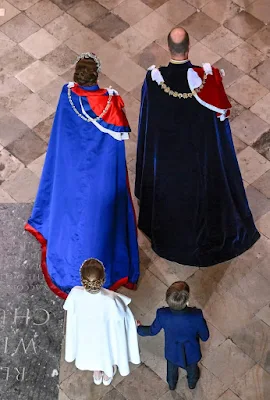 |
| William, the Prince of Wales wore his Garter Regalia |
Members of the Royal family who have been admitted to the Orders of the Garter (England) and Thistle (Scotland) wore their Order Regalia (Princess Alexandra opted to wear her Royal Victorian Order cape).
British royals who are not yet admitted to the Garter were told to wear their Royal Victorian Order cape (blue gown). Thus, we saw Princess Alexandra, Prince Michael of Kent, the Princess of Wales, the Duchess of Edinburgh, and the Duchess of Gloucester wearing a blue silk cape.
 |
| The Duke and Duchess of Gloucester. Prince Richard wore his Garter regalia while his wife wore her Royal Victorian Order cape |
 |
| Prince and Princess Michael of Kent. The prince wore his Royal Victorian Order cape |
However, it's surprising that the king's second son, Prince Harry, the Duke of Sussex, donned a morning suit. Why the Duke of Sussex was not wearing a RVO cape?
He has a Royal Victorian Order honor and could have worn the cape (Prince Michael of Kent is also not a working royal and yet he was wearing the RVO cape. And also Prince Andrew who is not a working royal and yet was allowed to wear his Garter regalia. But why Prince Harry did not wear his RVO cape?).
 |
| Prince Harry walked with the Yorks inside the church |
The King's Coronation was a scaled-down event, with just over 2,000 guests compared to his mother's Coronation in 1953 when more than 8,000 guests were invited to the ceremony.
In the 1953 Coronation, guests and members of the Royal Family wore coronets, tiaras, and coronation robes. And the celebration had a full display of sparkling jewels.
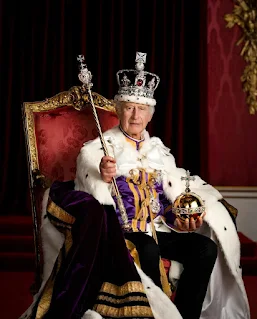 |
| Official portrait of King Charles III wearing the Imperial State Crown and holding the Sovereign's Orb and the Sovereign's Scepter with cross ©Hugo Burnand via The Royal Family |
King Charles III's wanted a more low-key ceremony, more sustainable and scaled-down, but despite this wish, still, his Coronation saw a full display of magnificent crown jewels because most of those pieces were part of the traditional ceremony that cannot be optional.
 |
| Coronation Regalia. Image: Royal Collection Trust |
The Crown Jewels are part of the Crown Property that cannot be sold nor auctioned. These jewels directly pass to the next monarch. They are considered the most symbolic national treasures.
They include over 100 extraordinary items including orbs, scepters, and crowns. All are closely connected with the status and role of the monarch.
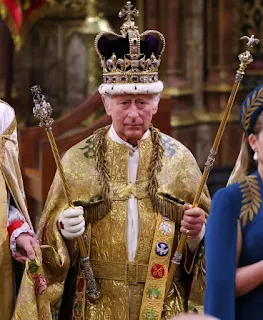 |
| King Charles III holding two scepters. Image: The Royal Family |
During the coronation service, the new British monarch is first anointed with holy oil, then dressed in coronation garments followed by the investiture ceremony with a number of ornaments symbolizing the chivalric nature of kingship.
Here are the 5 most symbolic Crown Jewels at King Charles III's Coronation:
1. St. Edward Crown - This splendid solid gold head sparkler is used to crown the British Sovereign for many centuries. It can only be worn during the Coronation ceremony, before and after the coronation ceremony, this crown is kept in the Tower of London. It weighs 2.07 kg.
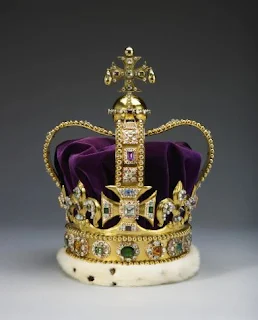 |
| St. Edward Crown. Image: Royal Collection Trust |
Made of solid gold and 444 gemstones, including rubies, garnets, sapphires, and tourmalines. It was originally made for the coronation of Charles II in 1661 to replace the medieval crown that was melted down in 1649 after the execution of King Charles I.
The original was thought to date back to the eleventh century and is believed to be the crown worn by King Edward I, called "The Confessor", the last Anglo-Saxon king of England who was declared a saint.
 |
| King Charles is crowned by the Archbishop of Canterbury with St. Edward crown |
The present St. Edward crown was commissioned by the Royal Goldsmith, Robert Vyner, in 1661 for the coronation of King Charles II from the Royal House of Stuart.
Although it is not an exact replica of the medieval design, it follows the original in having four crosses-pattée and four fleurs-de-lis, and two arches.
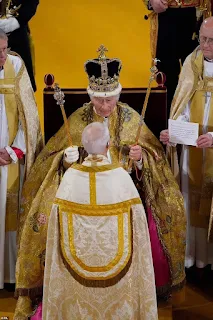 |
| The King was presented by two scepters |
It is made up of a solid gold frame set with rubies, amethysts, sapphires, garnets, topazes, and tourmalines. The crown has a velvet cap with an ermine band.
2. The Sovereign's Orb - Commissioned for the coronation of King Charles II in 1661 from the royal goldsmith Robert Vyner, the Sovereign's Orb formed from a hollow gold sphere, mounted with a zone and arc, and surrounded by clusters of emeralds, rubies, and sapphires.
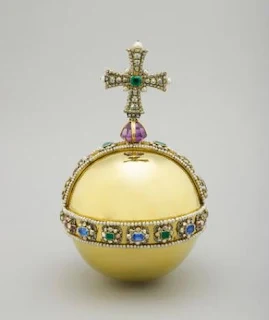 |
| Sovereign's Orb. Image: Royal Collection Trust |
This object is surrounded by rose-cut diamonds, each in a champleve enamel mount, between single rows of pearls. It measures 27.5 cm and weighs 1320 grams.
The monde is an octagonal step-cut amethyst, surmounted by a cross set with rose-cut diamonds, with a table-cut sapphire in the center on one side and an emerald on the other, and with pearls at the angles and at the end of each arm.
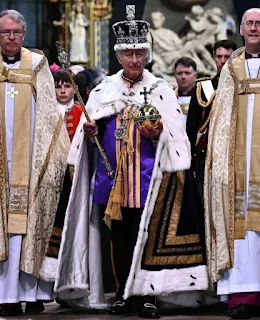 |
| Long Live Your Majesty! Image: The Royal Family |
The Sovereign's Orb is one of the most symbolic Crown Jewels during the monarch's coronation because it represents the sovereign's power and symbolizes the Christian world.
The cross is mounted on a globe, and the bands of jewels divide it up into three sections representing the three continents known in medieval times.
Following the investiture ceremony during the coronation service, the monarch will then be presented with the Sovereign's Orb, placing this object in the right hand of the monarch, before being placed on the altar.
3. Sovereign's Scepter with Cross - During the coronation service, the new monarch is presented with two scepters - the Sovereign's Scepter with Cross and the Sovereign's Scepter with Dove.
The Sovereign's Scepter with Cross was commissioned in 1661 for the coronation of King Charles II. The Sovereign's Scepter was made by the royal goldsmith, Robert Vyner.
 |
| Sovereign's Scepter with Cross. Image: Royal Collection Trust |
The Sovereign's Scepter with Cross comprises a gold rod, formed in three sections, with enameled collars at the intersections, surmounted by an enameled heart-shaped structure.
The heart-shaped structure holds a huge drop-shaped diamond, Cullinan I, also known as the Star of Africa (Cullinan diamond was mined from Pretoria, South Africa). This scepter weighs 530.2 carats.
This structure is surmounted by enameled brackets mounted with step-cut emeralds, and by a faceted amethyst monde, set with table and rose-cut diamonds, rubies, spinels, and emeralds.
Completing the scepter is the cross above, set with diamonds. It has a table-cut diamond on the front and an emerald on the reverse.
Beneath the Cullinan diamond are further enameled brackets, representing a crown, mounted with rubies and diamonds. The pommel of the scepter is enameled and mounted with rubies, emeralds, sapphires, and diamonds.
The Sovereign's Scepter with Cross symbolizes the sovereign's temporal power and good governance. Originally made for Charles II, this scepter has undergone a number of alterations, particularly in 1820 for the coronation of George IV, when an enameled rose, thistle, and shamrock were all added to the monde.
It was altered again in 1911 for the coronation of King George V, adding the Cullinan diamond. The structure which holds the diamond is hinged so that the stone may be removed and worn separately.
4. The Sovereign's Scepter with Dove - This scepter was commissioned in 1661 for the Coronation of King Charles II and was made by the royal goldsmith, Robert Vyner.
 |
| Sovereign's Scepter with Dove. Image credit: Royal Collection Trust |
The structure is formed from a plain gold rod, in three sections, with enameled and gem-set collars at the intersections, surmounted by a gold monde.
It has an applied silver zone and arc set with rose diamonds, and a gold cross supporting an enamelled dove with outspread wings.
The collars are mounted variously with rose- and table-cut diamonds, step- and table-cut rubies, emeralds, sapphires and spinels. At the base of the scepter is a compressed spherical pommel set with further rose-cut diamonds.
The Sovereign's Scepter with Dove symbolizes sovereign's spiritual role as Supreme Governor of the Church of England. The dove in the scepter represents the Holy Spirit.
According to the Royal Collection Trust, this scepter has been traditionally known as "the Rod of Equity and Mercy".
At the coronation of William I (the Conqueror) in 1066, this role was emphasized in a contemporary description: For by the scepter uprisings in the kingdom are controlled and the rod gathers and confines those men that stray. The monarch's pastoral care of his people is therefore bound up with this scepter or rod.
5. The Sovereign's Ring and The Queen Consort's Ring - During the coronation ceremony, the Sovereign's ring is placed on the fourth finger of the sovereign by the Archbishop of Canterbury, as a symbol of "kingly dignity". Since the thirteenth century, it has been traditional to include a ruby as the principal stone in the ring.
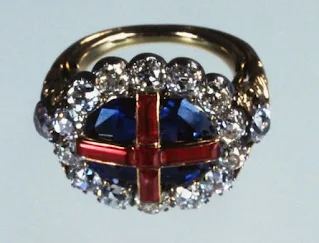 |
| The Sovereign's Ring originally made in 1831 for the coronation of King William IV. Image credit: Royal Collection Trust |
Until the reign of Queen Victoria, all British monarchs and the Queen consorts had new rings commissioned for their coronation ceremony.
However, since King Edward VII, the British Sovereign began using the ring of King William IV and the Queen Consort the ring of Queen Adelaide during their coronations.
 |
| King Charles III at his coronation |
The last British monarch who had a new ring for the coronation was Queen Victoria because her Uncle William's ring was too large for her small fingers. As a result, crown jeweler, Garrard, made a ring for her designed to look very similar to King William IV's sovereign’s ring.
The current Sovereign's Ring was commissioned for the coronation of King William IV in 1831, and made by the royal goldsmiths, Rundell, Bridge, and Rundell. It weighs 16.89 grams and measures 2.8 cm.
The ring is set in gold overlaid with four rectangular-cut and one square-cut ruby, butted together in a gold strip setting to form a cross with a border of 14 cushion-shaped diamonds and a diamond on each shoulder with a gold hoop.
It is composed of a mixed-cut octagonal sapphire in a gold setting overlaid with four rectangular-cut and one square-cut ruby.
The Sovereign's Ring is supposed to be a personal possession of the monarch. When King William IV died, his sovereign's ring went to his widow, Queen Adelaide. But the Queen bequeathed the ring to the King's niece and successor, Queen Victoria, together with her consort's ring.
Queen Victoria left both of these and her own coronation ring to the Crown in 1901, and all three were deposited in the Tower of London, with the other Crown Jewels, by George V in March 1919.
All sovereigns from Edward VII onwards have used William IV's ring at their coronations. The presentation of the ring forms part of the investiture of the coronation, which is preceded by the anointing with holy oil and is followed by the crowning itself.
Prior to the reign of King Edward VII (1901-1910), British Queen Consorts had a new ring commissioned for the coronation. The practice ended in 1911 when King Edward VII's wife, Queen Alexandra, used the ring of Queen Adelaide.
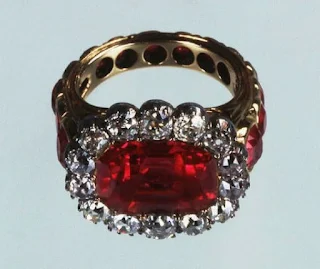 |
| The Queen Consort's Ring originally made for Queen Adelaide in 1831 |
Queen Adelaide's consort's ring comprises an extended octagonal mixed-cut ruby in a gold setting, unbacked, within a border of fourteen cushion-shaped brilliants set transparent in silver collets.
The gold shank is set with fourteen graduated mixed-cut rubies. Like the sovereign, the queen consort is presented with a ring during the coronation ceremony. It measures 2.0 cm and weighs 8.55 grams.
Like Queen Alexandra, Queen Mary and Queen Elizabeth the Queen Mother did not commission a new Queen Consort's ring and just used the Queen Adelaide's ring for the coronation. Queen Camilla did the same.
Official portrait of the King
The Royal Family shares today the official portrait of King Charles III in his coronation regalia but without the St. Edward Crown, instead, he wears the Imperial State Crown.
 |
| Official portrait of King Charles III taken by photographer Hugo Burnand |
He is holding the Sovereign's Orb, which symbolizes his power as a monarch and the Christian world, and the Sovereign's Scepter with a Cross, which symbolizes his temporal power and good governance.
His Majesty is not wearing the St. Edward crown because it is used only to crown the Sovereign and must be taken of after the coronation ceremony.
He left Westminster Abbey on Saturday wearing the Imperial State Crown, originally made for his grandfather, King George VI's coronation in May 1937.


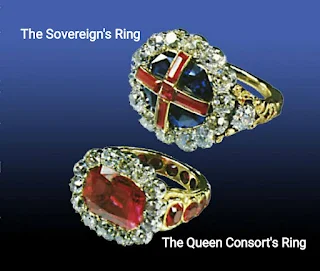





0 Comments